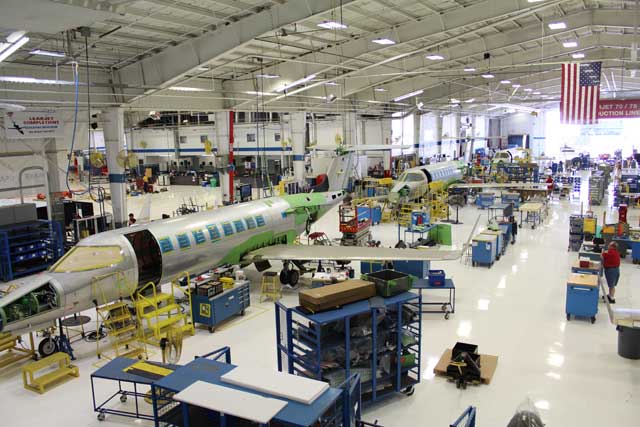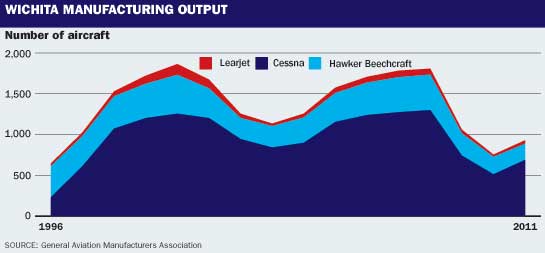Bombardier's Learjet factory complex in Wichita's southwest quarter is growing - in size, if not yet in output. Production of Learjet's super-light category aircraft remains stalled at roughly half of its 2007 peak, but construction projects under way will expand the site on the edge of Mid-Continent airport by 20% and produce a new paint hangar, delivery showroom and production flight building.
If it seems incongruous to see facility construction booming at the same time that aircraft production remains stagnant, then you have probably never worked in the general aviation business.
Ralph Acs, vice-president and general manager of Learjet production, seems to expect the question and has a rehearsed answer, referencing the first business jet Bombardier ever developed in Canada.
"When we go all the way back to the Challenger 300 days, it was developed in a down market. The whole notion here is, it's an opportunity," Acs says. "The opportunity is as we come out of this down market to truly have fresh, new products available."
Bombardier is not just opening new buildings in Wichita. It is also launching new jets. The all-composite fuselage Learjet 85 was conceived in 2007 and is closing in on first flight next year, but that was launched at the height of the last general aviation market cycle. Even as the market remained flat in 2011, Bombardier also launched the Learjet 70/75 programmes in secret, finally revealing them at the EBACE convention last May. Last month, Acs hinted that a smaller derivative of the Learjet 85 could soon emerge as well.
 |
|---|
The Learjet 70 and 75 are being manufactured in Wichita |
It is a familiar story in any downturn cycle, and particularly in this one. The three Wichita-based general aviation manufacturers are using the downturn to clean house and prepare themselves for a market recovery, if it comes.
Cessna has taken a similar course to its smaller rival Learjet. The largest of the three Wichita-based general aviation manufacturers is set next year to introduce the M2 light jet and high-speed Citation Ten, then deliver the super-light Latitude and super-midsize Longitude in two-year intervals.
Hawker Beechcraft, meanwhile, is undertaking a different sort of preparation for an eventual market recovery and has attempted to launch only one new product recently: the re-engined Hawker 400XPR. The company entered into bankruptcy in May, exchanging a $2.5 billion debt load for an equivalent ownership stake by its creditors. It then signed an agreement to enter exclusive negotiations with Superior Aviation Beijing to sell the non-defence business for $1.89 billion, but the deal fell apart by mid-October. It is now working to emerge from bankruptcy later this year as simply Beechcraft, having disposed of its Hawker-branded line of business jets.
In early September, Hawker Beechcraft chairman Bill Boisture said in an interview that current market conditions could force the industry to contract.
"We hope, pray and work like crazy for a bigger market, more buyer interest," Boisture says. "If there's not enough market size after you've worked, prayed and hoped, then the consolidation and restructuring of businesses takes place."
In the light and very light jet segment, for instance, the three Wichita manufacturers have been challenged since 2009 by Embraer, which entered the market with the Phenom 100. In two more years, Honda Aircraft could deliver the first HondaJet in the segment. Hawker Beechcraft claimed more than one-quarter of all deliveries in 2005, but could be crowded out of the market completely by the end of next year.
In theory, another company could acquire the Hawker-branded product line, which includes the Hawker 4000, 900XP, 800XP, 400XP and 200. But some analysts think the line-up, which accounted for 52 combined deliveries in 2011, will not survive the bankruptcy process.
 |
|---|
"We think it is more likely that most of the operations will be shut down," writes JP Morgan analyst Joseph Nadol in a recent research note to investors.
The renamed Beechcraft will be focused on the company's turboprop and piston aircraft products, which include the Baron G58, Bonanza G36 and four basic models of the King Air - C90, B200/250 and 350.
While Hawker Beechcraft finalises the terms of its restructuring, Cessna and Learjet are concentrating on being ready for the market recovery. It may, however, take another two years before the recovery in the light to midsize business jet sector really takes hold.
Scott Donnelly, chief executive of Cessna parent Textron, could not summon much optimism for a market rebound in business jets in 2013.
"The way I would see it in 2013, at this stage of the game, is going to be very much a repeat of the 2012 market," Donnelly says. "So the bulk of what's out there, the bulk of the activity that has to happen in terms of selling aircraft, is going to involve getting orders for aircraft. So that's the way we've been playing here for a while and I think at this stage of the game, that would be my view of how 2013 [will] play out."
Even so, neither Cessna nor Learjet seems to be hedging its bets on a market recovery in 2014.
"From a strategic perspective - you know we're in the down-market - we've leveraged it with respect to our factory and our processes within the factory," Acs says. "We're leveraging that with the development for the 70/75. The resources, to be honest, that we've been able to get during the last 18 months [have been] excellent. So we've been able to build a strong, capable team."
Clyde Cessna first started building aircraft in Wichita in 1916, five years after the first air show was held in a field outside town. Beech Aircraft was founded in 1932, and Learjet commenced operations 30 years later. Each is well acquainted with the boom-and-bust cycles of the general aviation market, but the severity and length of the current one still caught them by surprise.
"To be honest, nobody really thought this down period was going to be this long. It is long. It is difficult. It is painful. There is no doubt about all that," Acs says.
For Learjet, the downcycle meant falling from 80 aircraft deliveries in 2007 to only 28 three years later. Shipments improved to 43 in 2011, but remain far below the four-year average of 73 deliveries in 2005-2008.
 |
|---|
Market downturns are foiling product strategies conceived in more bountiful times. Learjet has recently announced an indefinite production pause for the Learjet 60XR. Cessna showed even worse timing in launching the large-cabin Citation Columbus in 2008. It would have occupied a category of the market that is currently in high demand, but financial concerns forced Cessna to suspend the project in 2000 and cancel it later in the year.
"It's so cyclical [historically], and they've been used to these ebbs and flows in sales. I think this is a different downturn than any of them have experienced before," says Debra Teufel, managing director for business development for the Greater Wichita Economic Development Coalition.
Boisture agrees with that assessment. His company has watched as the US market especially has transformed into a mature market, where aircraft sales are mainly linked to fleet replacement instead of growth. The difference is partly down to the US economy, and partly the result of new aircraft financing policies that require down payments of 20-30%, compared to just 5-10% only a few years ago.
"Do I think it's a normal cycle? No, I don't," Boisture says. "I think it's a shift and a paradigm change."
While painful, such stagnant periods can lead to positive changes. If companies are not distracted by bankruptcy restructuring, as in Hawker Beechcraft's case, they have the opportunity to prepare for the next cycle. Idle resources can be put to use in re-imagining how the company builds jets in peak production periods. There is time to become acquainted with and to learn how to use the latest new aviation and manufacturing technologies.
"There's been a lot of time and effort in this community devoted to composite materials, and how we make the aircraft more efficient and lightweight," Teufel says. "A lot of investments made in technology will probably mean fewer people working on the factory floor, but on the back of that there has to be people programming the machines, and so what it will ultimately mean for totally employment remains to be seen."
In Learjet's case, the focus during the downturn was not only on new aircraft design. The company also worked on redesigning how they build the aircraft. For instance, the Learjet 75 will be assembled in a way that reduces its cycle time by 42%.
That reduction was accomplished by focusing on eliminating out-of-sequence work. An example cited is the installation of the main cabin door and the over-wing exit door. Learjet previously waited to install both doors until after the aircraft was fuelled before its first take-off. The old process was considered necessary because the airframe tends to twist slightly after it is loaded with fuel. But Learjet engineers found a way to perform the installations correctly on the assembly line, saving potentially several hours of extra labour on the flight line.
Such incremental improvements are the reason why Learjet maintains a strong presence in Wichita, even as it outsources work to new start-up factories in Mexico.
Bombardier has made a practice of outsourcing aerostructures work to internal and external partners at other sites, and it initated that process with Learjet on the Learjet 85 programme.
The composite fuselage is being produced in a new Learjet factory in Querétaro, Mexico. The composite wing panels are fabricated at Bombardier's factory in Belfast, UK, then shipped to Querétaro to be attached to ribs and spars. Then, both the wing and the fuselage assemblies are trucked north to Wichita, where both will be assembled together and receive engines, control surfaces and landing gears. Wichita is also where the Learjet 85 will begin and complete its flight test programme next year.
That division of labour within Bombardier on the Learjet 85 is no accident, with Wichita performing the highly engineered tasks that are its core competency.
"It's a real skill to get through all the functional tests and systems installation," Acs says. "At the end of the day, where you do your final assembly is where you're going to do your flight testing, is where you're going to deliver your aircraft. This is the baseline. The Learjet is here, our growth is here, our investment is here."
It has become a new organisational model in the Wichita cluster. Low-skilled work by the original equipment manufacturers and even some suppliers is exported to lower-cost factories elsewhere, but the assembly and delivery tasks that require higher-value skill and experience is kept on site.
Hawker Beechcraft has opened sites in Mexico and even threatened to move final assembly to Louisianna, but received concessions from both local governments and unions that kept the company on Kansas soil.
"We've forged a way to stay here," Boisture says. "We've outsourced lower-complexity jobs to lower-cost areas, particularly in Mexico. That allows us to stay with the trained, highly skilled craftsmen that we have here for final assembly and delivery of airplanes, because we've been able to alter our cost base enough. I think it's much more likely at the macro-level for there to be consolidation than there to be destruction."
Source: Flight International
















